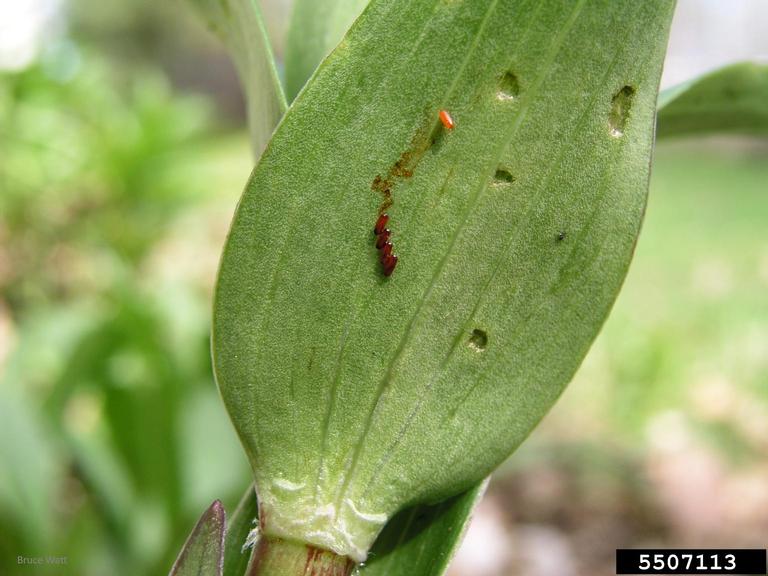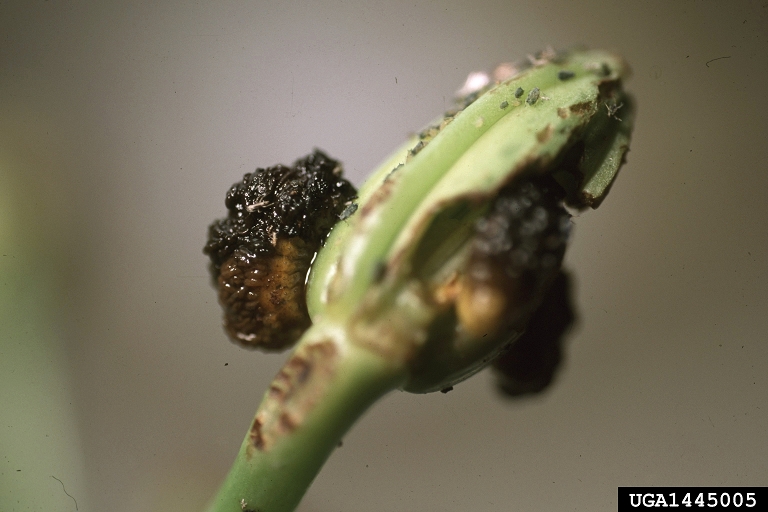Lily leaf beetles continue to spread in Michigan
Monitor lilies throughout Michigan’s growing season for signs of lily leaf beetle larvae, feeding damage or eggs.

The lily leaf beetle, also called scarlet lily beetle (Liliocerus lilii), is an invasive pest of growing concern in North America. Adults and larvae cause significant feeding damage on the leaves, stems and flowers of native and exotic lily species and hybrids (Photo 1). The primary hosts for lily leaf beetles are plants in the genus Lilium and Fritillaria. The beetles are commonly found on tiger lilies, Easter lilies, Asiatic and oriental lilie, and fritillaries, making them the most at-risk for significant feeding damage. Minor feeding damage can also occur on lily of the valley (Convallaria majalis), Solomon's seal (Polygonatum sp.), bittersweet (Solanum sp.), potato (Solanum tuberosum), hollyhock (Alcea) and various hosta species. Daylilies (Hemerocallis), calla lilies and canna lilies are not attacked by scarlet lily beetles.

Life cycle
This insect overwinters as an adult in the soil or leaf-litter, emerging in early spring and through June to lay 250 to 450 eggs. Eggs can be found on the underside of lily or fritillary leaves in irregular lines of three to 12 (Photo 2). The slug-like larvae hatch after one to two weeks and can feed from 16 to 24 days. Through their larval development, these orange-green larvae cover themselves in their own frass (excrement) to deter predators (Photo 3). The adults have a single generation and live for multiple weeks before returning to the soil, often near lilies.

Distribution
Native to Eurasia, the lily leaf beetle was initially discovered in North America in Montreal, Canada, in the 1940s and in the United States in 1992. Movement of bulbs is the presumed method that this insect has spread between countries. The beetle spread rapidly through New England in the mid- to late 1990s.
Researchers at the University of Rhode Island developed a biological control program using a small parasitoid that parasitizes the larvae of lily leaf beetle and have been successful at reducing population of lily leaf beetles.
Unfortunately for Michigan, lily leaf beetles were first found in 2016 in Jackson County. The range of this insect has slowly increased, with 2022 being a year where this insect fed heavily on lilies across parts of southeast Michigan and resulted in many reports to Michigan State University Extension.
What’s being done in Michigan?
Scientists at Michigan State University are studying the extent of lily leaf beetle populations and the possibility of a biological control program that was successful on the East Coast. While lily leaf beetle is now widespread across southeast Michigan, gardeners elsewhere with lilies elsewhere in the state are requested to report any finds of the scarlet lily beetle along with photos of plant damage to the Midwest Invasive Species Information Network.
Management options
As the scarlet lily beetle originates from outside North America, it has few natural enemies that are effective at control. Hand-picking beetles off plants and crushing or throwing in a bucket of water may provide relief if only a few beetles are present. Contact insecticides are the only other option. Products containing permethrin, cyhalothrin, deltamethrin, pyrethrin, spinosad and other insecticides labeled for ornamental use have shown the most effective control. Azadiractin (neem oil) products and insecticidal soaps have also shown some control of young lily leaf beetle larvae. If using an insecticide on flowering plants, read the label to follow directions and avoid exposure to pollinators.



 Print
Print Email
Email